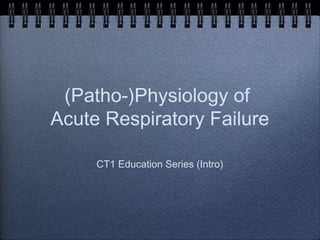
Pathophysiology of Acute Respiratory Failure
- 1. (Patho-)Physiology of Acute Respiratory Failure CT1 Education Series (Intro)
- 2. Respiratory Physiology Curriculum Gas exchange - O2 & CO2 transport, hypoxia & hypercapnia, hyper- and hypo-baric pressures Functions of Hb in O2 carriage & acid-base equilibrium Pulmonary ventilation: volumes, flows, dead space Effects of IPPV on lungs Mechanics of ventilation: V/Q abnormalities Control of breathing; acute & chronic ventilatory failure; effects of O2 therapy Non-respiratory functions of the lungs
- 3. Respiratory Failure pO2 < 8 kPa (60 mmHg) and/or pCO2 > 6 kPa (45 mmHg) Type I = hypoxia Type II = hypercapnia Type III = Perioperative (atelectasis) Type IV = Shock (Hypoperfusion)
- 4. Case scenario John is a (slightly weird) 23 year old with mild asthma. He is admitted to hospital with 3 day history of myalgia and fever, and increasing shortness of breath and cough over the last 36 hours. His room air O2 sats are 84% and his respiratory rate is 37/minute and shallow. He is using accessory muscles and there is active exhalation ABG: pH 7.34, pCO2 6.1 pO2 7.8 on air He is sweaty and tiring rapidly. You can detect creps at his right base and widespread wheeze.
- 5. Key Issues Mechanisms of hypoxia Work of breathing Dead space and alveolar ventilation Hypoxic pulmonary vasoconstriction Alveolar gas composition & A-aDO2 Shunt Effects of anaesthesia on all of these Effects of mechanical ventilation
- 6. Why is John hypoxic?
- 7. Why is John hypoxic? Mechanisms: Ventilation/perfusion (V/Q) mismatch Shunt Diffusion impairment Alveolar hypoventilation (normal A-aDO2)
- 8. What about John’s breathing pattern?
- 9. What about John’s breathing pattern? Increased work = increased O2 consumption Rapid shallow breathing = increased VD/VT ratio Rapid shallow breathing = turbulent flow Turbulent flow = increased work (vicious O) Bronchospasm = gas trapping
- 10. Work of breathing - f/VT
- 12. Dead-space Alveolar minute ventilation = MVA MVA = (tidal volume - deadspace) x RR Anatomical = volume of air in conducting airways Alveolar = gas volume in unperfused alveoli Physiological = anatomical + alveolar
- 13. Bohr Equation Volume of CO2 removed from ideal alveolar gas = volume exhaled in mixed expired gas %CO2Alv [=PaCO2] x VAlv [=VT-VD] =%CO2Exp x VExp [=VT] VD/VT = (PaCO2-PECO2)/PaCO2 Normal VD/VT = 0.2-0.3 Higher deadspace = bigger gap between PaCO2 and ETCO2
- 14. John’s still alive....just! You got worried and intubated John before he collapsed. After 15 minutes on the ventilator (PEEP 5, VT 550, rate 14, FiO2 80%) his pH is 7.34 pCO2 5.8 pO2 8.6
- 15. What is John’s A-aDO2? What does that mean?
- 16. Alveolar gas composition PAO2 = PIO2 - PaCO2/R PAO2 =Alveolar partial pressure of O2 PIO2 =FiO2 x (PB -PH2O) R = resp. quotient = 0.8 (ish) A-aDO2 = PAO2 - PaO2
- 17. Shunt & venous admixture Deoxygenated blood returning to left heart e.g. Bronchial veins (< 1% of CO) Thebesian veins from LV walls (0.3% of CO) Congenital heart disease Alveolar collapse Venous admixture = amount of mixed venous blood required to mix with pulmonary capillary blood to produce observed A-aDO2
- 18. Shunt equation (!) Total O2 delivery = cardiac output O2 content = Shunt O2 content + Pulmonary blood flow O2 content Cardiac output = total flow = Qt Shunt flow = Qs, Pulmonary flow = Qt-Qs CaO2 = arterial O2 content CvO2 = mixed venous O2 content CcO2 = pulmonary end capillary O2 content (calculated from alveolar gas equation & O2 dissociation curve) Qs/Qt = (CcO2 - CaO2)/(CcO2-CvO2)
- 20. How are you going to fix John? What is wrong with his lung compliance? How can the ventilator help? How will you know it is helping? How is it going to help his oxygenation?
- 21. Compliance
- 22. Lung Volumes
- 23. Closing capacity & volume Dependent airways close during expiration This occurs at closing capacity (CC) The closing volume = CC - residual volume CC < FRC in young adults CC is independent of position but FRC isn’t! CC = FRC at 44 years in supine position CC = FRC at 66 years when upright